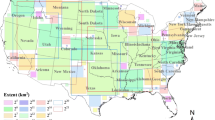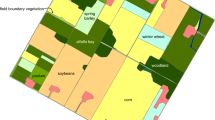Abstract
This paper examined the scale-dependent relationships between landscape structure (e.g., slope, elevation, and overstory canopy coverage) and microclimate (e.g., air and soil temperatures and soil moisture) at different spatial scales along a 10050 m transect in the Southeastern Missouri Ozarks, USA. The landscape structure and microclimate variables were measured every 10 m along the transect during the growing season, June to September, 1996. We used the simple correlation analysis and "moving window" technique (no overlap between two adjacent windows) to examine the correlation coefficients between landscape structure and microclimate variables at scales or window sizes from 10 m to 2000 m. Because the sample size decreased rapidly in the "moving window" method, we also used the standardized cross-variogram to investigate the relationships between landscape structure and microclimate variables at a larger range of scales from 10 m to 8000 m. We found that the relationships between landscape structure and microclimate were apparently scale-dependent along the transect, suggesting the interactions between landscape structure and microclimate were stronger at some scales than others. The landscape structure variables were poor in explaining the variation of each microclimate variable at fine scales (e.g., 10 m). The correlations between elevation and microclimate variables were, in general, significantly improved with the increase of scales, while the improvement was less significant for slope and canopy coverage. Of the landscape structure variables, elevation, in general, had a higher correlation with the microclimate variables than slope and overstory canopy coverage at most scales examined. Our results suggest that small scales (e.g., < 100 m) are not suitable to study the relationships/interactions between landscape structure and microclimate and larger scales (e.g., > 500 m) are more appropriate though the relationships vary at the larger scales. Both the simple correlation analysis and standardized cross-variogram analysis were effective and, in general, consistent in characterizing the scale-dependent relationships between landscape structure and microclimate. Meanwhile, the standardized cross-variogram had the advantage to examine the relationships at large scales over the correlation analysis because the sample size reduced rapidly in the correlation analysis.
Similar content being viewed by others
References
Beckett P.H.T. and Webster R. 1971. Soil variability: a review. Soils and Fertilizers 34: 1–15.
Bell G., Lechowicz M.J., Appenzeller A., Chandler M., Deblois E., Jackson L. et al. 1993. The spatial structure of the physical environment. Ecologia 96: 114–121.
Bohning-Gaese K. 1997. Determinants of avian species richness at different spatial scales. Journal of Biogeography 24: 49–60.
Breshears D.D., Rich P.M., Barnes F.J. and Campbell K. 1997. Overstory-imposed heterogeneity in solar radiation and soil moisture in a semiarid woodland. Ecological Applications 7: 1201–1215.
Brookshire B. and Hauser C. 1993. The Missouri Ozark Forest Ecosystem Project: The effect of forest management on the forest ecosystem. Internal Publications of Missouri Department of Conservation, Columbia, Missouri, USA.
Brosofske K.D., Chen J., Crow T.R. and Saunders S.C. 1999. Vegetation responses to landscape structure at multiple scales across a Northern Wisconsin, USA, pine barrens landscape. Plant Ecology 143: 203–218.
Chen J., Franklin J.F. and Spies T.A. 1993. Contrasting microclimates among clearcut, edge, and interior of old-growth Douglas-fir forest. Agricultural and Forest Meteorology 63: 219–237.
Chen J., Franklin J.F. and Spies T.A. 1995. Growing-season microclimatic gradients from clearcut edges into old-growth Douglas-fir forests. Ecological Applications 5: 74–86.
Chen J. and Franklin J.F. 1997. Growing-season microclimate variability within an old-growth Douglas-fir forest. Climate Research 8: 21–34.
Chiles J.P. and Delfiner P. 1999. Geostatistics: Modeling Spatial Uncertainty. John Wiley & Sons, New York.
Christensen N.L., Bartuska A.M., Brown J.H., Carpenter S., Antonio C., Francis R. et al. 1996. The report of the Ecological Society of America committee on the scientific basis for ecosystem management. Ecological Applications 6: 665–691.
Collins F.C. and Bolstad P.V. 2002. A comparison of spatial interpolation techniques in temperature estimation. http://www.sbg.ac.at/geo/idrisi/gis&environmental&modeling/sf&papers/ collins&fred/collins.html (Dissertation, Virginia Technological University, 1994).
Franklin J.F. 1997. Ecosystem management: an overview. In: Boyce M.S. and Haney A. (eds), Ecosystem management: applications for sustainable forest and wildlife resources. Yale Unversity Press, New Haven, pp. 21–53.
Haeuber R. and Franklin J.F. 1996. Perspective on ecosystem management. Ecological Applications 6: 692–693.
Hansen A.J., Garman S.L. and Marks B. 1993. An approach for managing vertebrate diversity across multiple-use landscapes. Ecological Applications 3: 481–496.
Holling C.S. 1992. Cross-scale morphology, geometry, and dynamics of ecosystems. Ecological Monographs 62: 447–502.
Hungerford R.D. and Babbitt R.E. 1987. Overstory removal and residue treatments affect soil surface, air, and soil temperature: implications for seedling survival. USDA For. Ser. Res. Pap., INT-377.
Kalkhan M.A. and Stohlgren T.J. 2000. Using multi-scale sampling and spatial cross-correlation to investigate patterns of plant species richness. Environmental Monitoring and Assessment 64: 591–605.
Kalkhan M.A., Stohlgren T.J. and Coughenour M.B. 1995. An investigation of biodiversity and landscape-scale gap patterns using double sampling: A GIS approach. In: Proceeding of the Ninth Conference on Geographic Information Systems. Vancouver, British Columbia, Canada, pp. 708–712.
Levin S.A. 1992. The problem of pattern and scale in ecology. Ecology 73: 1943–1967.
Mallants D., Mohanty B.P., Jacques D. and Feyen J. 1996. Spatial variability of hydraulic properties in a multi-layer soil profile. Soil Science 161: 167–181.
McCaughey J.H. 1982. Spatial variability of net radiation and soil heat flux density on two logged sites at Montmorency, Quebec. Journal of Applied Meteorology 16: 514–523.
Meisel J.E. and Turner M.G. 1998. Scale detection in real and artificial landscapes using semivariance analysis. Landscape Ecology 13: 347–362.
Qi Y. and Wu J. 1996. Effects of changing spatial resolution on the results of landscape pattern analysis using spatial autocorrelation indices. Landscape Ecology 11: 39–49.
Reed R.A., Peet R.K., Palmer M.W. and White P.S. 1993. Scale dependence of vegetation-environment correlations: a case study of a North Carolina piedmont woodland. Journal of Vegetation Science 4: 329–340.
Samu F., Sunderland K.D. and Szinetar C. 1999. Scale-dependent dispersal and distribution patterns of spiders in agricultural systems: A review. Journal of Arachnology 27: 325–332.
Saunders S.C., Chen J., Crow T.R. and Brosofske K.D. 1998. Hierarchical relationships between landscape structure and temperature in a managed forest landscape. Landscape Ecology 13: 381–395.
Shea K. and Chesson P. 2002. Community ecology theory as a framework for biological invasions. TRENDS in Ecology & Evolution 17: 170–176.
Stohlgren T.J., Falkner M.B. and Schell L.D. 1995. A modified-Whittaker nested vegetation sampling method. Vegetatio. 117: 113–121.
Stoutjesdijk P.H. and Barkman J.J. 1992. Microclimate: vegetation and fauna. OPULUS Press AB, Sweden, 216 pp.
Thomas J.W. 1996. Forest service perspective on ecosystem management. Ecological Applications 6: 703–705.
Turner M.G., O'Neill R.V., Gardner R.H. and Milne B.T. 1989. Effects of changing spatial scale on the analysis of landscape pattern. Ladscape Ecology 3: 153–162.
Walsh S.J., Evans T.P., Welsh W.F., Entwisle B. and Rindfuss R.R. 1999. Scale-dependent relationships between population and environment in northeastern Thailand. Photogrammetric Engineering & Remote Sensing 65: 97–105.
Wiens J.A. and Milne B.T. 1989. Scaling of ″landscape″ in landscape ecology, or, landscape ecology from a beetle's perspective. Landscape Ecology 3: 87–96.
Wu J. and Levin S.A. 1994. A spatial patch dynamic modeling approach to pattern and process in an annual grassland. Ecological Monograph 64: 447–464.
Xu M., Chen J. and Brookshire B.L. 1997a. Temperature and its variability in oak forests in the southeastern Missouri Ozarks. Climate Research 8: 209–223.
Xu M., Saunders S.C. and Chen J. 1997b. Analysis of landscape structure in the southeastern Missouri Ozarks. General Technical Report, NC-193. USDA, Forest Service, 41–55.
Xu M. and Qi Y. 2000. Effect of spatial scale on the relationship between plant species richness and microclimate in a forested ecosystem. Polish Journal of Ecology 48: 77–88.
Xu M., Chen J. and Qi Y. 2002. Growing-season temperature and soil moisture along a 10 km transect across a forested landscape. Climate Research 22: 57–72.
Young K.L., Woo M.K. and Edlund S.A. 1997. Influence of local topography, soils, and vegetation on microclimate and hydrology at a high Arctic site, Ellesmere Island, Canada. Arctic and Alpine Research 29: 270–284.
Zobel D.B., McKee A. and Hawk G.M. 1976. Relationships of environment to composition, structure, and diversity of forest communities of the central western Cascades of Oregon. Ecological Monograph 46: 135–156.
Author information
Authors and Affiliations
Corresponding author
Rights and permissions
About this article
Cite this article
Xu, M., Qi, Y., Chen, J. et al. Scale-dependent relationships between landscape structure and microclimate. Plant Ecology 173, 39–57 (2004). https://doi.org/10.1023/B:VEGE.0000026322.18998.cc
Issue Date:
DOI: https://doi.org/10.1023/B:VEGE.0000026322.18998.cc




